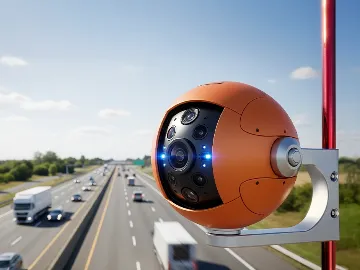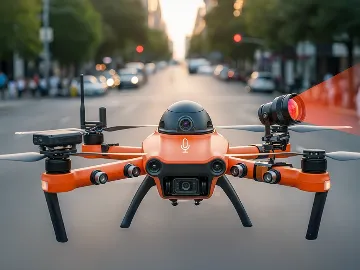Quality failures, inspection bottlenecks, and safety risks all have one thing in common: they start with something no one saw in time. Computer vision allows enterprises to detect, analyze, and act on visual information the moment it appears. It enables machines to analyse visual data in real time, identify irregularities, and make context-aware decisions. From paint quality checks to driver monitoring and road perception, computer vision connects production floors, supply chains, and vehicles into one continuous feedback loop of visual insight.
With computer vision in automotive, enterprises address the challenge of maintaining quality, safety, and efficiency at scale without adding cost or slowing production. In this article, we'll look in-depth at computer vision applications in the automotive industry, from manufacturing precision and supply chain visibility to driver assistance and autonomous navigation. You'll learn what challenges organizations face when implementing it and how experienced vendors like N-iX address them and build computer vision systems that perform reliably in real-world conditions.
How to leverage computer vision in automotive industry: Key use cases
Computer vision is an integrated intelligence layer connecting vehicles, production systems, and people. Across the automotive value chain, CV enhances operational efficiency, quality control, and road safety. Its applications can be divided into two major areas: in-vehicle systems, where it supports perception and driver assistance, and manufacturing operations, where it powers precision, consistency, and traceability.
Explore more details on computer vision use cases in transportation
In-vehicle applications: Safety and driving automation
Computer vision is the perceptual core of intelligent mobility. It allows vehicles to interpret their environment with accuracy that is no longer dependent on human perception. From safety assistance to fully autonomous navigation, vision-based systems now define how vehicles interact with the world.
1. Advanced driver assistance systems (ADAS)
ADAS integrates computer vision with radar and LiDAR sensors to provide vehicles with a continuous understanding of their surroundings. These systems are designed to minimize human error. Autonomous driving systems must react within 0.1 seconds faster than the best human drivers at 0.15 seconds [1].
Key ADAS capabilities include:
- Adaptive cruise control: CV algorithms analyze the distance and relative speed of surrounding vehicles, adjusting throttle and braking to maintain safe headway. Multi-camera fusion enhances responsiveness in dense traffic and low-visibility conditions.
- Lane detection and lane keeping assist Vision models identify lane markings, even when partially occluded or degraded, and provide corrective steering input when unintended drift is detected.
- Traffic sign recognition: High-resolution cameras paired with deep neural networks interpret traffic signs across lighting and weather variations.
- Collision avoidance and automatic emergency braking: Real-time object detection identifies potential hazards, calculates risk based on trajectory prediction, and triggers braking when necessary.
- Blind spot detection: Lateral cameras continuously monitor side zones, alerting drivers to unseen vehicles or obstacles during lane changes.
- High beam assist: Vision-based luminance detection adjusts headlights automatically to maximize visibility without dazzling oncoming drivers.
2. Autonomous driving systems (ADS)
Computer vision is indispensable to higher levels of driving automation. Unlike rule-based assistance systems, autonomous vehicles rely on perception and inference. They must see, understand the context, and act accordingly.
Core tasks of computer vision in automotive industry include:
- Environment perception: Cameras, often fused with LiDAR and radar, feed deep neural networks that detect and classify objects, interpret traffic lights, and assess drivable space in real time.
- Object detection and tracking: CV models such as YOLO, Faster R-CNN, or Vision Transformers continuously track moving and stationary entities to anticipate interactions several seconds ahead.
- Construction zone awareness: Specialized CV models are trained on rare or complex scenarios (recognizing cones, barricades, or temporary lane shifts), which are critical for reliable navigation in dynamic urban environments.
- 3D mapping and localization: Visual odometry reconstructs spatial context, allowing vehicles to determine their position with centimeter-level accuracy, even where GPS signals are unreliable.
- Semantic segmentation: Each pixel in a frame is categorized (road, vehicle, pedestrian, vegetation), enabling the car to understand scene composition and make high-stakes decisions.
3. Driver and cabin monitoring systems (DMS)
Monitoring the human behind the wheel remains essential as vehicles become more autonomous. Driver and cabin monitoring systems apply computer vision to assess driver alertness, detect risky behaviors, and improve the in-cabin experience.
Primary functions include:
- Drowsiness and attention monitoring (DAM): Eye-tracking and facial recognition models identify early signs of fatigue or distraction, issuing warnings or initiating corrective actions.
- Facial recognition: Ensures secure vehicle access and personalization for seat position, mirror alignment, and infotainment preferences based on recognized profiles.
- Occupant and child presence detection: Uses infrared and RGB cameras to detect seat occupancy and identify if a child or passenger is left inside after shutdown.
- Gesture recognition: Allows drivers and passengers to control infotainment and climate settings through natural gestures, minimizing manual interaction and distraction.
- Parking and surround view assistance: Vision system automotive merge inputs from multiple cameras to generate a 360-degree vehicle view, simplifying low-speed maneuvers and improving situational awareness.
Manufacturing, quality control, and assembly
In modern automotive production, precision is non-negotiable. Machine vision in automotive is integral to maintaining production efficiency for quality consistency and reducing operational risk.
1. Automated visual inspection and defect detection
Visual inspection is one of the earliest and most mature uses of computer vision in automotive, but its sophistication continues to evolve. Deep learning-based systems now perform fine-grained analysis on components, surfaces, and assemblies with precision that surpasses manual detection.
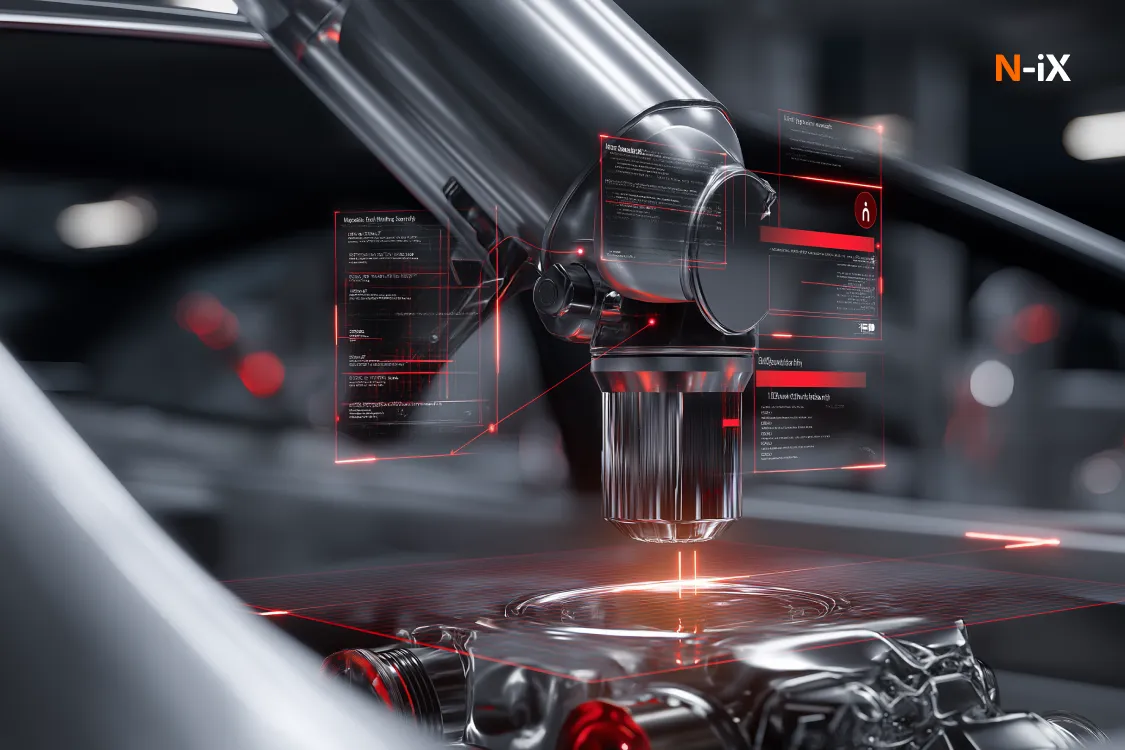
Component and assembly verification
Machine vision improves defect detection by up to 90%, achieving 95.6% accuracy in assembly line fault detection [2]. Automotive vision system continuously verifies whether each component is present, correctly oriented, and securely fastened. They inspect everything from wiring harnesses and brake assemblies to engine and transmission subcomponents.
Surface inspection
Surface quality remains one of the most critical indicators of manufacturing excellence. Computer vision in automotive, equipped with multi-angle and hyperspectral imaging, can detect surface defects as minor as a few micrometers:
- Metal parts inspection: Vision algorithms assess the integrity of stamped or forged components, identifying tears in aluminum panels, cracks in camshafts, or porosity in castings.
- Paint and finish inspection: Real-time image analysis evaluates gloss uniformity, color consistency, and microdefects such as dust inclusions or orange peel.
- Interior component inspection: High-resolution cameras verify stitching quality, material texture, and color alignment on seats, dashboards, and door panels. Even subtle deviations in pattern or assembly can be flagged automatically.
Weld inspection and gap/flush measurement
Welding accuracy directly impacts structural integrity and safety. Computer vision in automotive industry solutions use 3D laser profiling and structured-light sensors to evaluate weld geometry, detect voids, and verify continuity. They also measure gap (the distance) and flush (alignment) between body components such as doors, fenders, and tailgates.
EV battery and motor inspection
The rise of electric vehicles adds new inspection demands. Computer vision verifies cells' precise stacking and alignment within battery modules, checks for insulation integrity and coating quality, and identifies foreign particles or contamination. CV ensures accurate rotor-stator alignment in manufacturing and detects winding irregularities that could affect performance or safety.
N-iX has also developed advanced computer vision solutions to improve quality and safety control in the automotive industry. Our teams implemented AI-powered inspection systems capable of detecting missing components, weld defects, and surface imperfections in real time. These solutions significantly reduced false negatives and improved overall production consistency.
Read also: Use cases of agentic AI in automotive
2. Robotic automation and process control
Computer vision enables robots and assembly systems to adapt dynamically to real-world production variability. Instead of executing fixed trajectories, vision-guided robots analyze visual input in real time to determine object position, orientation, and condition even under unpredictable conditions.
- Vision-guided robotics: Robots equipped with stereo or 3D cameras perform complex operations such as welding, gluing, sealing, and painting with consistent accuracy. In windshield installation, for instance, vision algorithms calculate the exact spatial coordinates for glass placement.
- Assembly line monitoring and optimization: Computer vision tracks parts and assemblies as they move through each production stage. It measures component dimensions, verifies correct installation, and provides live data to manufacturing execution systems.
- Worker error proofing and assistance: Even in automated environments, human oversight remains vital. CV systems assist operators by verifying process adherence and confirming that the correct part or tool is used and assembly steps follow prescribed sequences.
- Ergonomic risk assessment: Computer vision contributes to workforce safety. Pose estimation and motion analysis identify repetitive or high-strain movements that may cause musculoskeletal injuries.
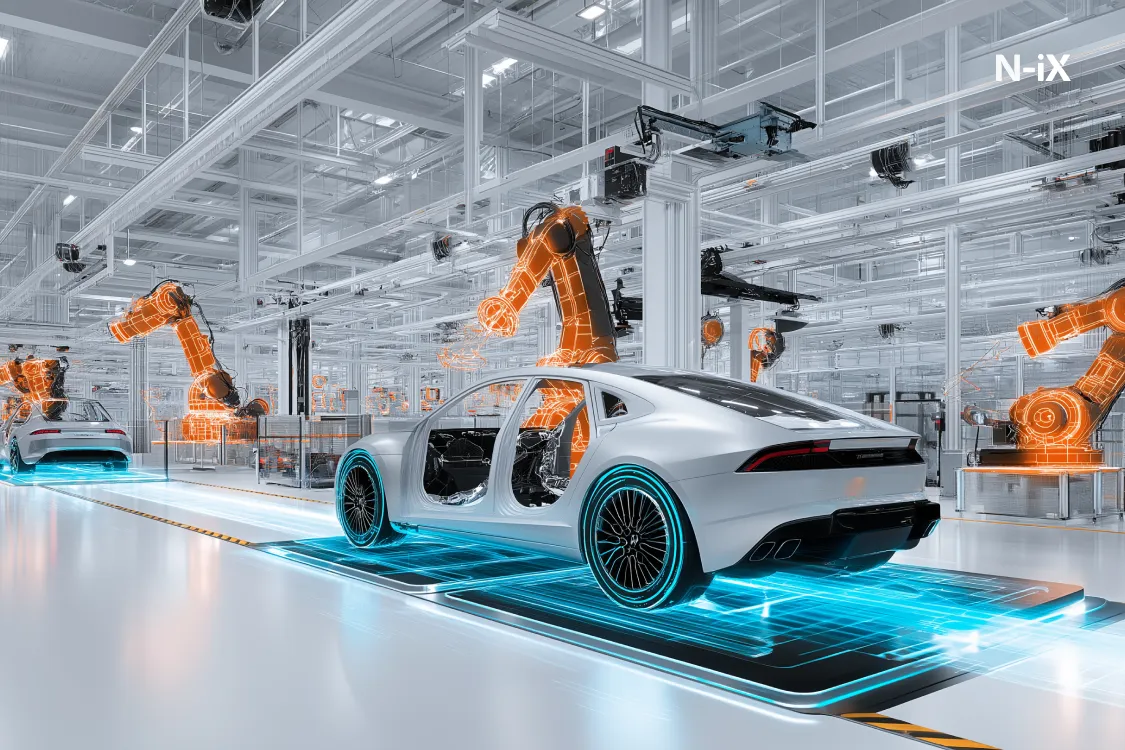
3. Tracking, traceability, and measurement
Traceability and dimensional control are cornerstones of automotive manufacturing. Computer vision brings unprecedented precision and speed to these processes.
- Optical character recognition and verification: High-resolution cameras capture and interpret serial numbers, barcodes, and dot-peened markings on every part. OCR verifies critical identifiers such as Vehicle Identification Numbers (VINs) and batch codes, linking them to digital records for compliance and warranty analysis.
- Supply chain visibility: Computer vision enhances end-to-end material tracking by integrating visual data with ERP and warehouse management systems. It monitors transit parts, verifies inventory accuracy, and automatically validates inbound and outbound shipments.
- Metrology and dimensional measurement: Advanced metrology systems use cameras as non-contact measurement tools for high-precision engineering analysis. CV systems can estimate wheel alignment angles (toe, camber) or measure body panel curvature with sub-millimeter accuracy.
Transportation and traffic safety analysis
The impact of computer vision in the automotive domain extends far beyond the vehicle itself. As mobility ecosystems become more connected, visual intelligence is increasingly used to monitor and optimize transportation networks. Computer vision enables real-time analysis of road conditions, traffic behavior, and infrastructure performance.
1. Traffic safety modeling
Computer vision introduces a proactive, data-rich alternative. Through object detection and tracking, CV algorithms extract detailed vehicle trajectories from video sources such as roadside CCTV, UAV footage, or infrastructure-mounted sensors. These trajectories are then analyzed using Surrogate Safety Measures (indicators like time-to-collision, post-encroachment time, and deceleration rate) to assess the likelihood of potential conflicts long before an actual accident occurs.
This shift from historical to predictive safety modeling enables transportation authorities and city planners to identify hazardous intersections, evaluate road design changes, and optimize signal timing based on empirical behavioral data rather than assumptions. Combined with AI-driven simulation tools, the approach allows continuous, non-intrusive road safety monitoring without disrupting daily traffic flow.
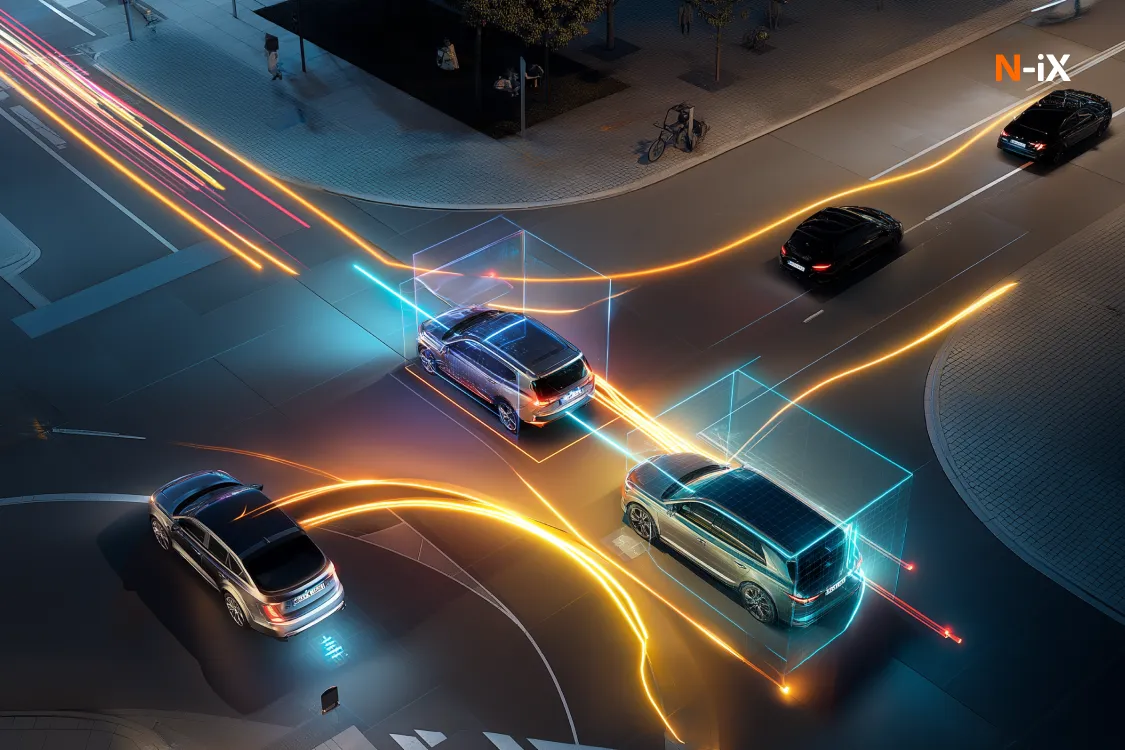
2. Traffic flow optimization
Computer vision provides this macro-level visibility by continuously analyzing real-time traffic video streams to extract flow patterns, vehicle speeds, queue lengths, and turning ratios. The insights feed directly into adaptive traffic control systems, allowing dynamic signal timing adjustment, lane assignments, and routing recommendations. Integration with vehicle-to-infrastructure (V2I) systems further extends this intelligence: CV data from roadside cameras can be shared with connected vehicles to improve travel time prediction and reduce idling.
3. Vehicle counting and monitoring
Accurate traffic data underpins every aspect of infrastructure management, from capacity planning to maintenance scheduling. Computer vision automates vehicle counting and classification with high temporal and spatial precision, differentiating between passenger cars, trucks, buses, and motorcycles across varied lighting and weather conditions.
This capability eliminates the limitations of inductive loop detectors and manual surveys, enabling continuous, fine-grained data collection at a fraction of the cost. Beyond traffic analytics, CV-based monitoring supports applications in environmental modeling (linking vehicle type to emissions) and toll-by-vehicle-class systems.
Read more about prominent use cases of computer vision in security
4. Automatic license plate recognition
Automatic license plate recognition (ALPR) is one of the most mature computer vision applications in transportation. Using high-resolution cameras and OCR-based deep learning models, ALPR systems identify and verify vehicle registration plates under diverse conditions.
Beyond enforcement and toll collection, ALPR is growing in urban mobility management and security. It supports access control in restricted zones, enables real-time tracking for stolen or unregistered vehicles, and assists in analyzing traffic composition for planning and demand forecasting. In commercial contexts, fleet operators use ALPR data for dispatch coordination, route optimization, and automatic log generation, reducing administrative workload while improving compliance.
A practical example of computer vision in transportation comes from an N-iX project focused on improving urban traffic safety and law enforcement. The team developed real-time AI models that detect driver distraction and seat-belt violations using roadside video streams. The system achieved over 90 % accuracy for distracted driving detection and around 88% for seat-belt monitoring, enabling traffic authorities to identify violations automatically and at scale. Beyond enforcement, the solution provided valuable analytics on driver behavior patterns, supporting smarter traffic management and more data-driven policy decisions.
More details on implementing computer vision for our client
How to mitigate major challenges of computer vision implementation in automotive
When a vehicle identifies a pedestrian or a defect in a weld, the decision seems instantaneous. Behind that moment lies an ecosystem of cameras, neural networks, calibration routines, and safety checks: all working within tight physical and regulatory constraints. Implementing computer vision in automotive environments means orchestrating this invisible complexity so that perception stays dependable under every possible condition.
Below is an overview of the most critical obstacles, followed by how N-iX approaches them in practice.
Driving and environmental challenges
Perception reliability defines system safety. In practice, computer vision must operate flawlessly under unpredictable and changing environmental conditions: fog, glare, rain, snow, dust, or partial camera obstruction. These factors distort visibility and contribute to data drift, where models trained under controlled datasets lose precision when exposed to new or degraded imagery. Complex real-world traffic introduces additional unpredictability: occlusions, rare events, and erratic motion patterns that standard training data cannot anticipate.
How N-iX addresses it: We build hybrid perception systems that fuse camera, radar, and LiDAR data for redundancy and situational consistency. Our teams use synthetic data augmentation and continuous retraining pipelines to keep models robust under weather, lighting, and sensor drift scenarios. We also deploy edge-optimized architectures and advanced scheduling mechanisms that ensure sub-100-millisecond inference latency even on constrained hardware.
Technical and computational constraints
Autonomous systems must process terabytes of visual and sensor data daily under strict latency, energy, and thermal constraints. Balancing model accuracy with real-time speed remains a fundamental engineering trade-off. High-performance GPUs provide the throughput needed for inference but can compromise electric vehicle efficiency, while lighter edge processors risk lag in decision-making.
How N-iX addresses it: Our engineers design hardware-aware models tailored to specific compute environments, using quantization, pruning, and model distillation to reduce load without degrading precision. N-iX also establishes MLOps pipelines that manage large-scale datasets, monitor performance metrics, and automate retraining.
Sensor and data integration
Computer vision rarely works alone. Reliable perception depends on precise sensor fusion, synchronizing and integrating data from cameras, radar, and LiDAR. Even minor calibration shifts or timestamp mismatches can produce perception inconsistencies. Meanwhile, developing and labeling sufficiently large, diverse datasets remains resource-intensive. Existing public datasets often fail to capture critical edge cases, long-term environmental variations, or region-specific road structures.
How N-iX addresses it: We develop multi-sensor fusion frameworks with automated calibration and timestamp alignment to maintain geometric accuracy across the vehicle lifecycle. Our engineers implement semi-supervised learning, active learning, and auto-labeling techniques to accelerate data preparation while improving quality.
Manufacturing and industrial challenges
In factory settings, computer vision must deliver precision at production speed. Reflective surfaces, variable lighting, and high-velocity motion all strain image quality. Traditional rule-based inspection systems lack flexibility, while deep learning approaches require extensive data and careful calibration to handle complex defects or changing assembly configurations.
How N-iX addresses it: We implement AI-driven visual inspection solutions to detect subtle anomalies across glossy and textured materials. Our optical specialists design adaptive lighting systems using polarized and structured illumination to eliminate glare and ensure consistent capture quality. These vision modules integrate directly with MES and PLC systems, creating closed-loop feedback that allows real-time defect correction and continuous process optimization.
Whether your objective is autonomous navigation, factory inspection, or predictive maintenance, N-iX helps automotive companies make computer vision work where it matters most in production, traffic, and the hands of millions of end users. Our teams combine deep AI expertise, automotive-grade engineering, and decades of system integration experience to help manufacturers and mobility providers bring production-ready computer vision solutions.
We approach every engagement as a full-cycle process: starting with business goals such as improved quality yield, lower downtime, or safer autonomy, and designing tailored architectures that balance accuracy and compute efficiency. Our engineers design data pipelines, MLOps frameworks, and edge deployment environments that keep vision systems learning, adapting, and performing under changing conditions. We test across thousands of real and synthetic scenarios, from glare and fog to reflective surfaces and high-speed motion.
If your next step is to make computer vision actually work in production, start with a team that's done it before.
FAQ
What are the most common use cases of computer vision in automotive?
The main computer vision use cases in the automotive industry include Advanced Driver Assistance Systems, autonomous driving, driver and occupant monitoring, automated visual inspection and defect detection, and smart manufacturing and logistics. CV systems are also used in predictive maintenance, vehicle damage assessment, and traffic safety analytics.
What challenges do enterprises face in implementing computer vision systems?
Enterprises often face challenges such as data drift, environmental variability (fog, glare, rain), limited labeled data, integration with legacy systems, and high computational demands for real-time inference.
How long does it take to deploy computer vision in automotive production lines?
Deployment timelines vary depending on scope and maturity. A proof of concept (PoC) can take 6-12 weeks, while a full production-ready system typically takes 6-12 months. Factors include data collection, model training, hardware calibration, validation, and compliance testing.
How is computer vision integrated with other automotive AI systems?
Computer vision integrates closely with other automotive AI modules through sensor fusion, edge computing, and MLOps pipelines. In vehicles, it connects with radar, LiDAR, and telematics systems for comprehensive situational awareness. In manufacturing, CV integrates with IoT, robotics, and quality-management platforms to form a unified data and control ecosystem.
References
- Applications of Computer Vision in Autonomous Vehicles: Methods, Challenges and Future Directions - School of Engineering and Technology, UNSW Canberra
- Machine Vision based quality inspection for automotive parts using edge detection technique - IOP Conference Series
Have a question?
Speak to an expert



